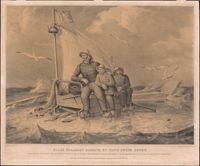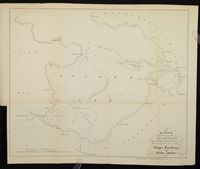A Zuyder Sea story
Stuck on ice for 14 days
Our extraordinary story really happened and is recorded at first hand by three notables of a Vollenhove commission and published on May the 15th in 1849. Our story starts in Durgerdam that very year when fisherman Klaas Bording (45) and his two oldest sons Klaas jr. (19) and Jacob (17) came in a critical situation.
In the winter of 1848-1849 the Zuyder Sea is partly frozen due to a period of temperatures below zero. In winter fisherman had no income and the only way to earn some money is to go out for ice fishing.
A common practice was to search for shallow water, position fishing nets under the ice, then make noise, scare up the flounder fish on the sea bed and catch them. From a centre hole in the ice a pole with a length of approx. 17 m is used to position nets between 4 additional holes in the ice. The nets with leads on the underside and cork on the top now form a square.
Fisherman Bording lost his vessel in 1833, is still paying debts and he has 6 children to feed. On the Saturday morning of the 13th of January 1849 Bording had sold the catch of the night before in Amsterdam, so he and his sons go out ice fishing late that day. They went off walking, towing with them a sledge with poles, ropes, nets, axe, cover sail and for proviant bread and a full tea kettle. Spots close to the coastline are already occupied by other fisherman. The weather had changed already, but the ice was thick and it was save to go out.
To find a suitable spot they go further out on the ice, much further. They go south in the direction of Muiden. In the course of the day they catch hundreds of flounders in the shallow waters of Pampus. The catch is very good that day: more than 700 fish. Then twilight set in. Although other fisherman return home, Bording and sons keep giving it another try. A decision with far reaching consequences.
After a long period of frost, it had started to thaw more than the day before and strong wind and rain plague the three fisherman. Then they notice that the dipstick drags on the sea floor. They realise this can only mean one thing: the ice on which they are standing had come loose and was adrift. A bit earlier they heard the tower clock of Muiden strike 1 o’clock at night, its pitch dark now and they are alone. They decide to stay put until daylight.
Here starts an incredible journey that will last for 14 days. The three fisherman suffer unimaginable hardship on their drifting and melting ice floe: cold rains, thick fog and sometimes clear sunshine. Variable wind directions zigzag the rudderless fisherman to the North, then to the East or South. Ice floes slide over each other, collide and break off. A couple of times the man are forced to step over onto a bigger ice floe. They have to get rid of all unnecessary weight, including part of their catch. The water that splashes over the floe is ice cold and their feet are swollen. To stay alive they eat the raw flounders.
Sometimes salvation is at close hand. They have land in sight near Marken and they pass the Eem estuary and recognize the church tower of Nijkerk, but they remained unnoticed. After a week, on a foggy Sunday, they drift very near and along a coast. They are so close that they hear dogs bark in the streets of Enkhuizen. Their desperate call for attention is not been heard and the wind drifts the ice floe away from the shore again. They fear the current and wind will drive them into the Northsea. This does not happen. Instead they float towards Urk. They pass Schokland, where they can even see people walking around. Here they notice a Tjalk, a freighter. Skipper Otten from Zwartsluis is trying to make his way through the ice floes, but does not notice the three yelling man. The freighter disappears into the horizon.
The 1849 report from de Vollenhove commission does not mention lighthouses and harbour lights. We know from for example Schokland that it was practise not to waste resources on the light when there was no traffic during a frozen sea. The lighthouse keeper was not payed when he didn’t fire the light. Even when the coal and petroleum light was replaced in the 1920’s by an automatic ignited gas light, it was switched on stand-by when the sea was frozen. Ice formation was also a potential danger to buoys, so they were often taken away.
By now the three man on the melting ice floe are in de vicinity of Vollenhove. A resident actually spots three distant dark dots on the ice and wonders if that could be people. But the idea is too absurd, it probably is ground ice, clods of earth frozen on top of an ice floor. A wind shift drifts the tree man away from shore again.
Above Vollenhoven seagulls have dropped leftovers of herring, an indication for fishermen that there are ice free spots in the sea. Driven by poverty, skippers Kroes and Visser take a chance. Draggging a net between the two small vessels deliverd the first catch of that year and they want to sail out again next day. So, on Saturday the 27th of January the two leave the small harbour. for a second attempt. Near Kraggenburg the catch is bad and they head home, but they decide for a detour. It is then when they hear yelling from the ice. Their vessels, so called Punters, are way too small to get through the ice mass around the three man. One of the vessels sails to Vollenhove for assistance. Help comes and with great difficulty it is possible to reach the three exhausted fisherman.
Back on shore they take care of the three men and mom Marretje Bording-Staats is informed. She arrives just in time, her son Klaas jr. dies on February 4th and her husband Klaas Bording three weeks later on February 25th. Both are buried in Vollenhove. Marretje returns home with son Jacob only.
The original gravestone can be seen in the Zuiderzee museum in Enkhuizen. The grave in Vollenhove is covered by a replica.

